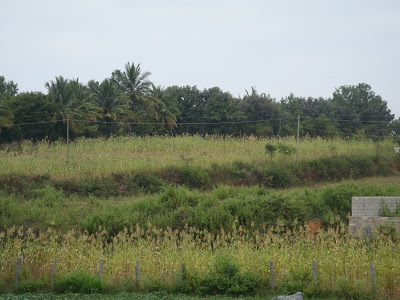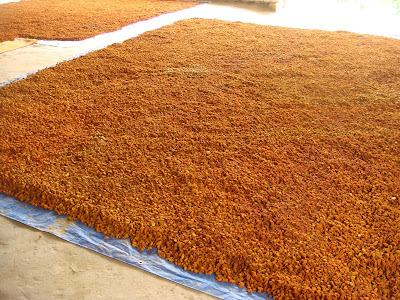You drive down Kanakpura road, pass the Art of Living Ashram on your right, and drive on until you see a signboard that says ‘Fireflies’. There, you take a right turn. After you have left behind shabby tenements, the green fields begin.
One should be careful not to get lost and ask, in case of doubt, for ‘Fireflies’.


This is Fireflies on your left and a lake on your right.


Continue on the mud trail and then swerve to your left and you have reached.

AMRUTADHARA GOSHALA
An initiative to protect, promote, develop and research Indian breed of cows, established by Sri Sri Raghaveshvara Bharathi of Ramachandrapura Matha, Sri Samsthana, Gokarna, in 2004.

This is one of the seven Goshalas in the state (Karnataka). There is one in Kerala too.
In this Goshala, there are 130 cows in all. There are 26 different breeds.

Seeing them all tied one beside the other actually made me see the differences, the variety. Otherwise it is difficult to imagine so many different breeds and actual physical differences.

There were totally 1400 breeds in India out of which only 33 are surviving today.
The reason is that cows of Indian breed have not been encouraged/supported/bred and foreign breeds like the Jersey cow are encouraged.
The Indian breed does not yield as much milk as the Jersey cow. The yield is not proportionate to the fodder it consumes. Not only is the quantity of milk low, but also the milk yielding duration within the cow’s lifespan is less, the result being that milk and by products obtained from the Indian cow are more expensive for the consumer compared to those of the Jersey cow.
On the whole, the Indian cow is considered uneconomical and receives no care, attention, nor investment.
Another example of how the ‘indigenous’ suffers and even becomes extinct in the face of foreign competition. A specific case of the broad generalization that free trade and free market are nothing more than idiocy, that regulation by the State is extremely important, that the consumers are shortsighted fools, that most of the products that enter a market when you open it wide are mostly products that we don’t need (although not in the case of milk since we need a large supply of milk for this population)
The fact that the milk of the Jersey cow may not have the same medicinal value as that of the Indian cow is not factored in by the consumer while evaluating price.
A specific case of the broad generalization that while computing economic viability, we only take into account quantitative factors and not qualitative factors and therefore the popular economic theory built on the incomplete formula, is such a misleading farce.
Apart from economy, the fact that we have to protect our home species from extinction is the kind of social responsibility you don’t expect from our people who see nothing beyond their pocket.
It is saddening to know that of the 1400 breeds, only 33 are surviving today and the rest have become extinct.
Initiatives such as this Goshala come as a respite.
They bring in stray cows from various parts of the country into the Goshalas and nurture them – give them fodder, water, control their breeding, clean them, clean the sheds, milk them, collect the refuse from their bodies – for everything that comes from a cow lends itself to use – there is not an iota of waste – a reason why the cow is called Kamadhenu …
I even had the chance to meet the veterinary doctor who had come on his periodic visits to this place. He was highly appreciative of the effort made by the caretakers of the place. It is funded mostly by donations from people.








Sometimes, injured, disabled cows, such as the calf below without a whole leg, are brought in and they are accepted.

Since the breeding is controlled, they do not permit cross breeding between different species, but only pure breeding. 28 yrs is the ideal life span but actual life span is 22 years on an average.

There is greenery surrounding the Goshala. Farms of coconut, arecanut, coffee plantations…

Another shed…






Turmeric being made into Kumkum. That’s another thing they do here.



I did not know Kumkum is made out of turmeric.
Pure kumkum powder is prepared with ancient methods used by our sages.
Procedure: Make a solution with 3/4th litre of lime juice, 150 gm borax and 10 gram alum. Soak 1 kg dry turmeric pieces in this solution for 24 hours. Dry in shade for a month, make fine powder, add 100 gms (10% of Turmeric quantity) of pure ghee made of cow’s milk, mix and sieve to obtain pure kumkum.
In the market, we often get coloured powder as kumkum that can cause skin allergies/diseases and other ailments.
A small yellow slip given me carried the Kumkum making procedure along with this “Kumkum has a very significant place in Indian society. Men and women, according to our tradition, are supposed to wear kumkum on their foreheads every day. Kumkum is believed to be auspicious. It has been proved to have the power to affect the state of our body as well as mind. According to Ayurveda too, Kumkum has medicinal property…”






The office of the chief caretaker.

Buttermilk. Offered to every visitor for free. This too is authentic – it’s made not by diluting curd as is done everywhere these days, but by churning and removing butter.

The equipment you see is used to process cow’s liquid refuse or urine. Out of 20 litres of cow’s urine, 11 litres of purified urine is available.

The urine (Gomutra) for the purpose of processing thus is collected between 4 and 6 in the morning everyday for it is 100% medicine.
That collected later in the day has only 70% medicinal value.
When heated as shown, vapours of Gomutra rise upwards into the tube. These vapours are met by cool water flowing through an outer concentric tube. The vapour thus turns into liquid and is collected in a container placed at the other end of the tube. It is then filtered through a piece of fine cloth. The liquid is almost colourless and odourless. It is fit for consumption. It is called Go-Arka. It has immense medicinal value and is a proven cure for BP, diabetes. Even if you have no health concerns you could still consume this for health benefits –both physical and mental.
How to consume Go-Arka – after brushing your teeth in the morning, on empty stomach – mix 2 spoons of Go-Arka with 4 spoons of boiled, cooled water and consume. For 1 hour after wards, nothing should be consumed.






After the first eleven litres, the cooled vapour begins to be strong in colour and odour and not fit for consumption. This is used to make a sort of phenoyl that could be used for cleaning – mopping the floor etc. This is believed to have properties that keep away insects, mosquitoes etc.
The container when drained of all the liquid is found to have pasty material stuck to its surfaces. This is collected and dried and called Go-gandha. This too can be used for application on skin where there is a cut, bruise, allergy. Mix a pinch of Go-Gandha with Go-Arka and make a paste before applying.

The brown bottles contain Go-Arka, whereas the yellowish liquid in containers below is phenoyl (a name they use for disinfectant).

Do visit this place, make generous contributions and help protct the cow. Amrutadhara Goshala, Dinnepalya, Kaggalipura, Kanakpura Road, Banaglore – 560082
Phone – 28432724




I want to conclude by telling you that I feel proud that Ramabhadrachar, my father’s maternal uncle, a great Sanskrit scholar and preceptor to many seeking knowledge was the guru of Swami Bharati Theertha for several years. :-)











10 comments:
Sowmya,
You will be called a fundamentalist and charged with promoting Saffron Gastronomical Systems unless u prove with scientific evidence that cow urine has medicinal benefits.
Gomutra or Panchgavya has been granted PATENTS ( U.S. Patents (No. 6410059 and 6896907) for its medicinal properties, particularly for its use along with antibiotics for the control of bacterial infection and fight against cancers.
The same is the case with Indian Breed of Horses too.
You can read about a similar effort to save indian horses in Rajasthan -
http://www.horseindian.com/
India had these five breeds - Marwari, Kathiyawari, Manipuri, Spiti and Zanskari.
Marwari Horses were brave and extremely intelligent and too loyal.
The Horse of MahaRana Pratap Singh,Chetak saved him from the mughal assault in the Battle of Haldighati.
Maharana erected a monument or veeragallu in memory of his beloved horse.
But these horses were castrated and killed during the British Period bcoz they felt they were far superior and intelligent than the british horses. Also they wanted to dismantle the rajputs from their horses and thereby the KSHATRIYA identification.
--- Horse + Cow + Elephant lover
@horses--my dad used to tell me that horses that loose the race are brutally killed by using a some machine that sucks--the blood away.
@goshala-- thats a wonderfull place, Students from school and elders needs to visit and get educated.
I have seen lot of such indian cows in gokarana. AT goakarna--in every brahmin house--you can see cute cows and calves--beign loved:)
Hi Sowmya, my name is Giridhar and I want to compliment you on your soothing and amazingly experiential form of writing. I still remember your piece on waking up to the fragrance of deodar wood while you were on holiday somewhere, the description made one feel that one was there in that place, your piece on the struggle with quickly solidifying coconut oil somewhere in the Himalayas, was very very evocative. Your last two pieces however had too many photographs and perhaps did not indulge your skill much. Anyways your blog is a refreshing place to visit when looking for some soul food.
I used to blog earlier before I moved to domestic BPO and got stuck with 12 hour work days and a 6 day week and now I can't seem to find my blog :)
Anjz,
I heard that horses that lose the race, horses or grow old and become 'useless' to mankind are simply shot.
Have you read Black Beauty? - You should - you will learn how men torture them in different ways - not only for utilitarian purposes but for the purpose of worthless fashion...
I will visit Gokarna...
Giri, Thanks for all the nice words... and for your patience :) You should start blogging again...
Anjz,
I would suggest you read MAHABHARATHA - in the midst of the fierce battle, Krishna feels that horses are tired and thirsty.
He orders Arjuna to create a Artificial Lake in the midst of the battle ground. Arjuna creates a compound with arrows surrounding the lake, so that horses are not troubled.
Krishna takes the horses - Kamagha,Sugreeva, Meghapushpa and other two horses into the lake and quenches the thirst.
You will learn how krishna takes care of the horses in different ways like grooming etc with absolute love and compassion for them , even in the midst of battle.
That is why Krishna is a complete man.
@anonymous-krishna is synonymous to Love--:)
Yeah I will read Mahabaratha for sure:).As of now i am reading sri padha vallabh chrithamarutha.This book is very divine .
I used to think mahabaratha as a book of-> war affair.Thanks for bringing up the-scene.
@Sowmya:Yeah I have read black beauty.Its Story told by a Horse.
My grandpa had narrated it and had gifted that book to me.
Thinking about "Moo ho!" movement to complement "Jai ho!" song..learnt a lot about cows and horses...if only i had the cow's ability to rechew that delicious rava laddoo served in desi festival!
any idea if they let us adopt a cow from their gowshala? I brought in a couple of desi cows from sirsi to my farm in gauribidanur. So wanted to know if they lend us the cows, of course with an agreement. Lest i need to visit the ramachandrapura mutt.
This page has concluded my search of a Desi Gau Shala with Desi Breed Gau only - Thank you So much - I will visit the place asap.
Desi Gau is a Miracle - know more about it here
https://www.facebook.com/Gau.Hamaari.Maata.Hai/
Thank You
Post a Comment